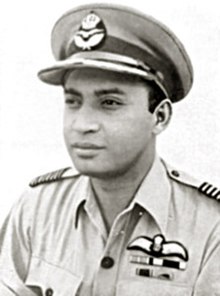Subroto Mukerjee | |
|---|---|
সুব্রত মুখোপাধ্যায় | |
 Air Marshal Subroto Mukerjee (pictured wearing Group Captain's insignia, c. 1947) | |
| 4th Chief of the Air Staff and Commander-in-Chief, Indian Air Force | |
| In office 1 April 1954 – 8 November 1960 (redesignated as Chief of the Air Staff from 1 April 1955) | |
| Preceded by | Gerald Ernest Gibbs |
| Succeeded by | Aspy Merwan Engineer |
| Personal details | |
| Born | 5 March 1911 Calcutta, Bengal Presidency, British India |
| Died | 8 November 1960 (aged 49) Tokyo, Japan |
| Relations | See Nibaran Chandra Mukherjee family and Das Family |
| Awards | Order of the British Empire |
| Military service | |
| Allegiance | |
| Branch/service | |
| Years of service | 1932–1960 |
| Rank | Air Marshal |
| Unit | No. 1 Squadron IAF |
| Commands | Air Force Station Kohat No. 1 Squadron IAF |
| Battles/wars | Annexation of Hyderabad Indo-Pakistani War of 1947–1948 World War II Waziristan campaign (1936–1939) |
Subroto Mukerjee OBE (Bengali: সুব্রত মুখোপাধ্যায়) (5 March 1911 – 8 November 1960) was an Indian military officer who was the first Indian Commander-in-Chief (C-in-C) of the Indian Air Force. He was awarded several honours during the course of a three-decade-long career, ended by his untimely demise in 1960. Mukerjee has been called the "Father of the Indian Air Force."
Born in a Bengali family of repute, he was educated both in India and in the United Kingdom. He joined the Royal Air Force and later was one of the first recruits of the Indian Air Force (IAF) in 1933. He flew with the No. 1 Squadron IAF from 1933 to 1941. He saw extensive action in the North-West Frontier Province during this stint and was mentioned in dispatches. He attended the Staff College, Quetta in 1941 before returning to command No. 1 Squadron in 1942. He commanded the RAF Station Kohat from 1943 to 1944 before moving to Air HQ as director of flying training. He was awarded the OBE in 1945.
Following the Partition of India, he was appointed Deputy Air Commander, Royal Indian Air Force. After completing the higher command course at the Imperial Defence College, he was appointed Commander-in-Chief of the IAF in 1954. He oversaw the transformation of IAF into an all-jet force. From 1955, he also served as the Chairman of the Chiefs of Staff Committee. He died while on a visit to Tokyo in 1960. His accidental death came as a shock to the Air Force and the nation and he was cremated with full military honours in New Delhi.
He had many firsts to his credit: the first Indian to command a flight, in 1938, the first Indian to command a squadron, in 1939, the first to command a station, in 1943, and finally, the first Indian to command the Service itself, in 1954.